New preprint by the Jena-Reich labs, The Genomic Formation of Human Populations in East Asia, by Wang et al. bioRxiv (2020).
Interesting excerpts (emphasis mine):
Mongolia Neolithic cluster
The three most ancient individuals of the Mongolia ‘East’ cluster are from the Kherlen River region of eastern Mongolia (Tamsag-Bulag culture) and date to 6000-4300 BCE (this places them in the Early Neolithic period, which in Northeast Asia is defined by the use of pottery and not by agriculture). These individuals are genetically similar to previously reported Neolithic individuals from the cis-Baikal region and have minimal evidence of West Eurasian-related admixture (…)
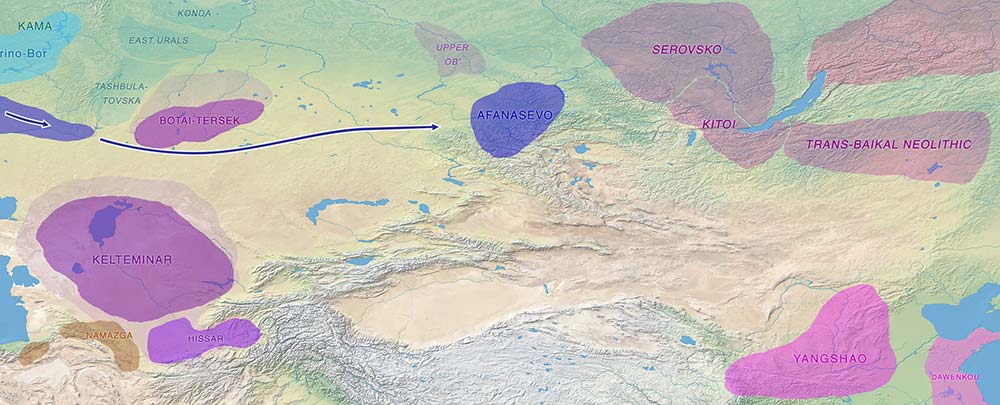
Early Afanasievo haplogroup variability
The two oldest individuals from the Mongolia ‘West’ cluster have very different ancestry: they are from the Shatar Chuluu kurgan site associated with the Afanasievo culture, with one directly dated to 3316-2918 calBCE (we quote a 95% confidence interval here and in what follows whenever we mention a direct date), and are indistinguishable in ancestry from previously published ancient Afanasievo individuals from the Altai region of present-day Russia (…)
The early Afanasievo individual from Bayankhongor aimag with precise radiocarbon date is of hg. R1b1a1a2a1a-P310/L52, which – if confirmed with BAM inferences – would date the expansion of this lineage back to Late Repin instead of the later West Yamnaya migration, in line with the earlier mean estimates of the BigY Tree (based on Iain Mathieson’s calculations), as opposed to YFull. The other individual is of hg. J1, possibly of the same subclade as the Khvalynsk chieftain reported by Anthony (2019).
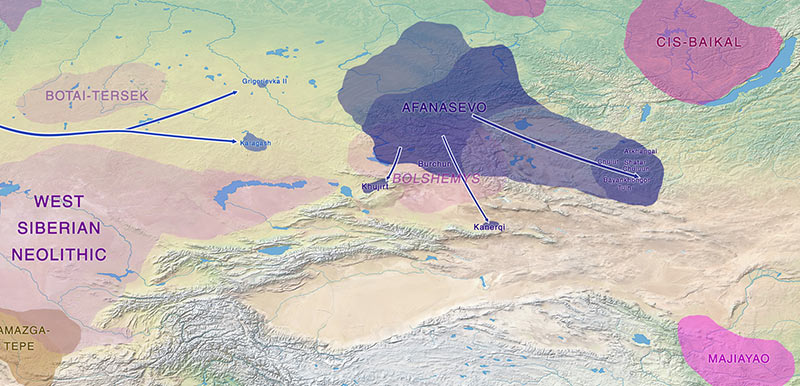
Late Mongolians without Steppe ancestry
A large number of groups could be modeled as simple two-way admixtures of Mongolia_East_N as one source (in proportions of 65-100%) and WSHG as the other source (in proportions of 0-35%), with negligible contribution from Yamnaya-related sources as confirmed by including Russia_Afanasievo and Russia_Sintashta groups in the outgroup set. The groups that fit this model were not only the two Neolithic groups (0-5% WSHG), but also the Early Bronze Age people from the Afanasievo Kurgak govi site (15%), the Ulgii group (28%), the main grouping of individuals from the Middle Bronze Age Munkhkhairkhan culture (33%), Late Bronze Age burials of the Ulaanzuukh type (6%), a combined group from the Center-West region (27%), the Mongun Taiga type from Khukh tolgoi (35%), and people of the Iron Age Slab Grave culture (9%).
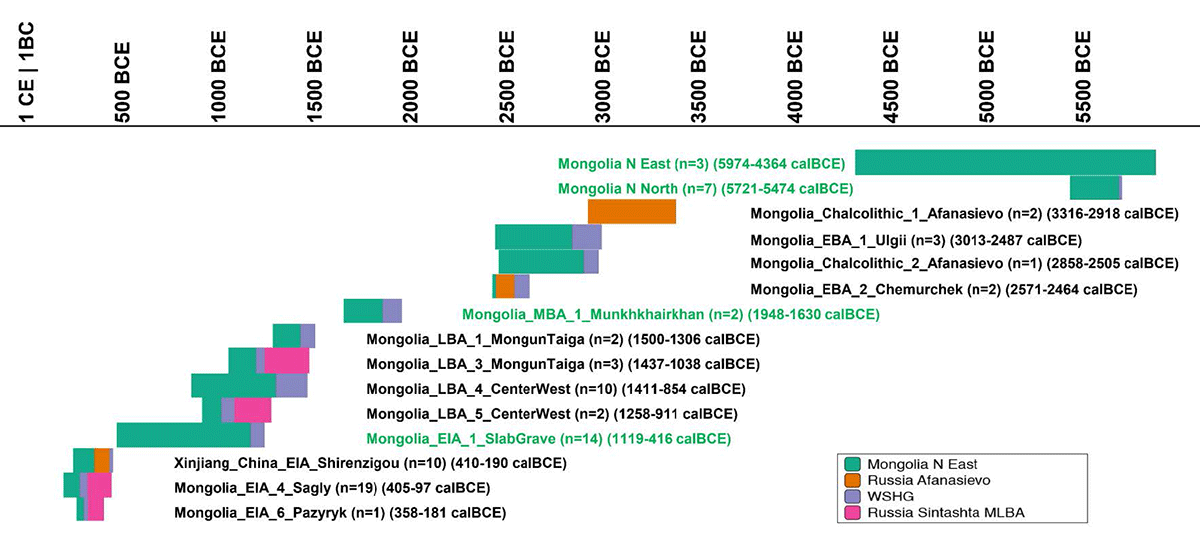
Afanasievo shows local admixture
A striking finding in light of previous archaeological and genetic data is that the male child from Kurgak govi (individual I13957, skeletal code AT_629) has no evidence of Yamnaya-related ancestry despite his association with Afanasievo material culture (for example, he was buried in a barrow in the form of circular platform edged by vertical stone slabs, in stretched position on the back on the bottom of deep rectangular pit and with a typical Afanasievo egg-shaped vessel; his late Afanasievo chronology is confirmed by a direct radiocarbon date of 2858-2505 BCE). This is the first known case of an individual buried with Afanasievo cultural traditions who is not overwhelmingly Yamnaya-related, and he also shows genetic continuity with an individual buried at the same site Kurgak govi 2 in a square barrow (individual I6361, skeletal code AT_635, direct radiocarbon date 2618-2487 BCE). We label this second individuals as having an Ulgii cultural association, although a different archaeological assessment associates this individual to the Afanasievo or Chemurchek cultures, so it is possible that this provides a second example of Afanasievo material culture being adopted by individuals without any Yamnaya ancestry.
Interestingly, I13957 is a male of haplogroup C2b1a1, a subclade possibly coincident with that of a Chemurcheck individual reported by Hollard (2014, 2018), suggesting an infiltration of Asian lineages and ancestry among evolving Pre-Tocharians, as it was expected based on the haplogroup diversity among Shirenzigou individuals. The Ulgii I6361 sample is a female.
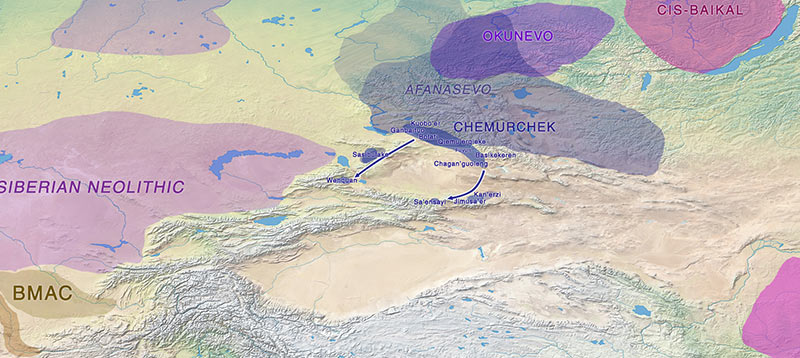
Chemurchek continues Pre-Tocharian Afanasievo
The legacy of the Yamnaya-era spread into Mongolia continued in two individuals from the Chemurchek culture whose ancestry can be only modeled by using Afanasievo as one of the sources (49.0%±2.6%). This model fits even when ancient European farmers are included in the outgroups, showing that if the long-distance transfer of West European megalithic cultural traditions to people of the Chemurchek culture that has been suggested in the archaeological literature occurred,26 it must have been through spread of ideas rather than through movement of people.
Both sampled Chemurchek individuals are of haplogroup R1b1a1a2a2-Z2103, in line with their almost direct genetic continuity with Afanasievo and with the two other reported samples to date (one C, one R1b).
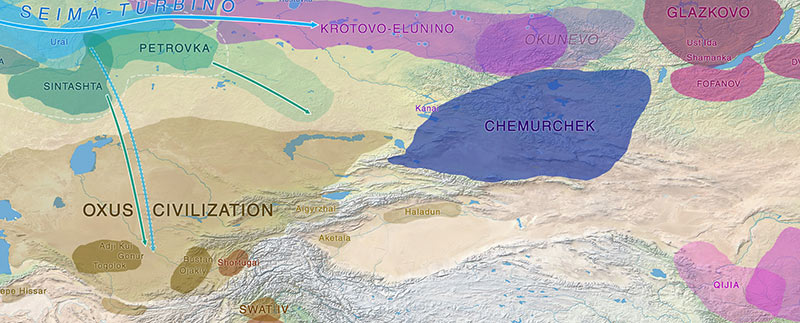
Abashevo-related ancestry
(…) in the Late Bronze Age and Iron Age and afterward we have data from multiple Mongolian groups whose Yamnaya-related ancestry can only be modeled as deriving not from the initial Afanasievo migration but instead from a later eastward spread into Mongolia related to people of the Middle to Late Bronze Age Sintashta and Andronovo horizons who were themselves a mixture of ~2/3 Yamnaya-related and 1/3 European farmer-related ancestry. The Sintashta-related ancestry is detected in proportions of 5% to 57% in individuals from the Mongolia_LBA_6_Khovsgol (a culturally mixed group from the literature), Mongolia_LBA_3_MongunTaiga, Mongolia_LBA_5_CenterWest, Mongolia_EIA_4_Sagly, Mongolia_EIA_6_Pazyryk, and Mongolia_Mongol groups, with the most substantial proportions of Sintashta-related ancestry always coming from western Mongolia. For all these groups, the qpAdm ancestry models pass when Afanasievo is included in the outgroups while models with Afanasievo treated as the source with Sintashta more distantly related outgroups are all rejected.
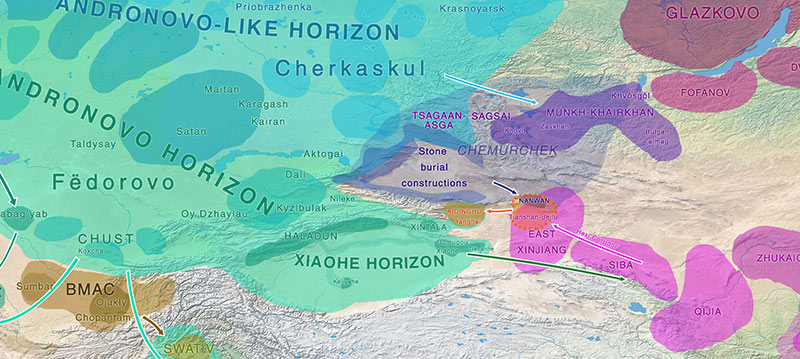
Afanasievo ancestry in the Iron Age
While the Afanasievo-derived lineages are consistent with having largely disappeared in Mongolia by the Late Bronze Age when our data showed that later groups with Steppe pastoralist ancestry made an impact, we confirm and strengthen previous ancient DNA analysis suggesting that the legacy of this expansion persisted in western China into the Iron Age Shirenzigou culture (410-190 BCE). The only parsimonious model for this group that fits according to our criteria is a 3-way mixture of groups related to Mongolia_N_East, Russia_Afanasievo, WSHG. The only other remotely plausible model (although not formally a good fit) also requires Russia_Afanasievo as a source.
The findings of the original study that reported evidence that the Afanasievo spread was the source of Steppe ancestry in the Iron Age Shirenzigou have been questioned with the proposal of alternative models that use ancient Kazakh Steppe Herders from the site of Botai, Wusun, Saka and ancient Tibetans from the site of Mebrak in present-day Nepal as major sources for Steppe and East Asian-related ancestry. However, when we fit these models with Russia_Afanasievo and Mongolian_East_N added to the outgroups, the proposed models are rejected (P-values between 10-7 and 10-2), except in a model involving a single low coverage Saka individual from Kazakhstan as a source (P=0.17, likely reflecting the limited power to reject models with this low coverage). Repeating the modeling using other ancient Nepalese with very similar genetic ancestry to that in Mebrak results in uniformly poor fits.
Thus, ancestry typical of the Afanasievo culture and Mongolian Neolithic contributed to the Shirenzigou individuals, supporting the theory that the Tocharian languages of the Tarim Basin—from the second-oldest-known branch of the Indo-European language family—spread eastward through the migration of Yamnaya steppe pastoralists to the Altai Mountains and Mongolia in the guise of the Afansievo culture, from where they spread further to Xinjiang. These results are significant for theories of Indo-European language diversification, as they increase the evidence in favor of the hypothesis the branch time of the second-oldest branch in the Indo-European language tree occurred at the end of the fourth millennium BCE.
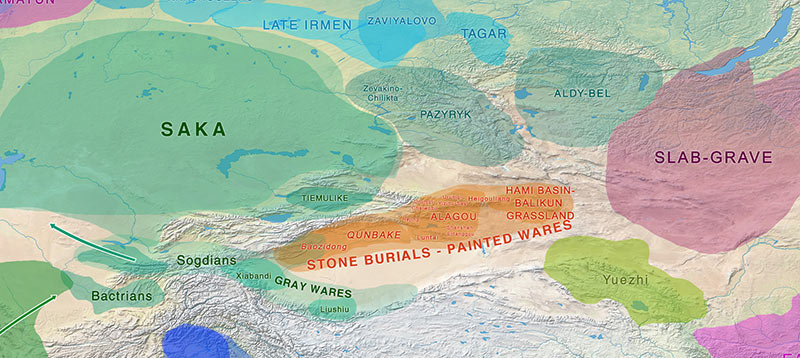
Wrap-up
This paper confirms the previous finding by Ning et al. (2019) about Common Tocharians of (or close to) Iron Age Shirenzigou continuing the ancestry of Pre-Tocharian Afanasievo, now with a direct intermediate link through Chemurchek as the transition into Proto-Tocharian, with even more (chronologically and geographically) close populations from Mongolia and China to compare to, dismissing all potential alternative models.
For a more detailed account of Tocharian evolution, see Proto-Tocharians: From Afanasievo to the Tarim Basin through the Tian Shan.
There are surely some very interesting complex admixture events of Uralic-speaking peoples of Abashevo-related ancestry and R1a1a1b2-Z93 lineages (here simplistically identified as “Sintashta/Andronovo-like”) with populations of Mongolia Neolithic- and WSHG-related related ancestry and (mainly) haplogroups Q1a, C2, and N1c1a, in areas that would later see the emergence of Samoyedic and Altaic-speaking peoples, some probably related to Yeniseian, so I am going to need to examine each of these groups one by one.
I will try to add samples to the Ancient DNA Dataset and publish Y-DNA and mtDNA maps to have first a simple visual of haplogroups, and maybe later something else, because this paper is huge.
Related
- Samoyedic shows Yeniseic substrate; both influenced Tocharian
- Yamnaya replaced Europeans, but admixed heavily as they spread to Asia
- Bronze Age cultures in the Tarim Basin and the elusive Proto-Tocharians
- Proto-Tocharians: From Afanasievo to the Tarim Basin through the Tian Shan
- Iron Age Tocharians of Yamnaya ancestry from Afanasevo show hg. R1b-M269 and Q1a1
- Aquitanians and Iberians of haplogroup R1b are exactly like Indo-Iranians and Balto-Slavs of haplogroup R1a
- A study of genetic diversity of three isolated populations in Xinjiang using Y-SNP
- Consequences of Damgaard et al. 2018 (II): The late Khvalynsk migration waves with R1b-L23 lineages
- The origin of social complexity in the development of the Sintashta culture
- Sintashta diet and economy based on domesticated animal products and wild resources
- The genetic and cultural barrier of the Pontic-Caspian steppe – forest-steppe ecotone
- Steppe and Caucasus Eneolithic: the new keystones of the EHG-CHG-ANE ancestry in steppe groups
- On the origin of haplogroup R1b-L51 in late Repin / early Yamna settlers
- Corded Ware ancestry in North Eurasia and the Uralic expansion